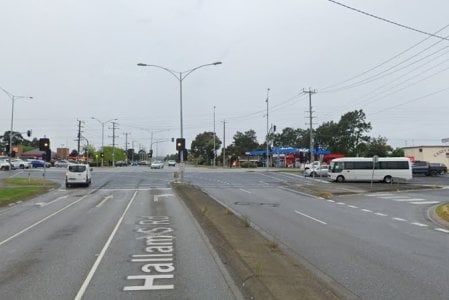Driven to despair: Young driver's $900 setback sparks road rule ruckus!
- Replies 18
Navigating the roads can be a complex affair, with a myriad of rules and regulations that drivers must adhere to.
However, sometimes, even the most diligent of drivers can find themselves caught in a legal tangle that can prove costly.
This was the case for a driver who found herself almost a thousand dollars out of pocket after a car accident that she believed was not her fault.
On October 13, an otherwise ordinary Friday evening, Izzy Singh was driving to the local pub with a friend when she followed the flow of traffic on a green arrow, turning right onto the Princes Highway from Belgrave-Hallam Road in Victoria.
To her shock, another vehicle ran through its red light and collided with her car at high speed.
The impact was severe enough to total her car and break her hand.

After the collision, Singh attended to her friend and the other driver before locating her phone amidst the wreckage and promptly contacting the police.
Upon their arrival, both Singh and the unlicensed driver provided statements.
It was during this process that Singh learned the other driver was asserting they also had the right of way.
‘It was definitely a red light for them, no other car came through from her side,’ Singh claimed.
‘And two cars had gone before me turning right, because it was a green arrow.’
In the aftermath of the crash, Izzy, who had full comprehensive insurance, faced a gruelling process with her insurer, AAMI, and the police to get her insurance claim approved, and the $900 excess paid out after her car was written off.
‘I was calling them every week or so,’ Singh recalled.
Victoria Police reported that Casey Highway Patrol members conducted an investigation into the incident, which involved examining whether any nearby businesses had CCTV footage capturing the collision.
However, they confirmed that ‘no CCTV or independent witnesses to the collision were located’.
‘Without further evidence, it was unable to be determined who was at fault, so, therefore, no charges were laid,’ they added.
On Tuesday, March 26—five months after the incident—despite her assertions and the circumstances of the accident, AAMI notified Singh via email that she would be considered responsible for the accident, citing the absence of CCTV footage as the reason for their decision based on a technicality in the Australian Road Rules.
The rule in question, number 62, deals with 'Giving way when turning at an intersection with traffic lights.'
While part one of the rule states that ‘A driver turning at an intersection with traffic lights must give way,’ the second part specifies that ‘A driver who is turning at an intersection with traffic arrows showing a green traffic arrow need not give way to an oncoming vehicle if the driver is turning in the direction indicated by the green traffic arrow.’
However, with ‘contradictory accounts by both parties in the police report, and a lack of valid evidence to hold someone fully accountable’, AAMI stood by their decision.
‘In these circumstances, we then look at the accident scenario with the appropriate road rules, and in this case, it is that a driver turning at an intersection with traffic lights must give way,’ a spokesperson explained.
Nevertheless, Singh contended that the road regulation referenced by AAMI is not applicable to her situation, as she had a green arrow, as specified in the second part mentioned earlier.
AAMI had subsequently been reached for additional clarification regarding their decision, particularly concerning Izzy's assertion regarding the green arrow.
AAMI's recommendation following the incident was for drivers to use dashcams, which ‘are very useful in determining the person at fault in an accident if there is a dispute’.
‘This can help save drivers who didn’t cause the accident from having to pay an excess. In some cases, dashcam footage is more valuable than witness statements, especially if it is clear and captures the direct cause of an accident,’ they stated.
Singh's ordeal underscored the significance of having concrete evidence to support one's account in the event of a road incident.
This sentiment is further reinforced by the revelations from another incident which highlighted how dashcam footage can serve as crucial evidence in exposing reckless behaviour on the road.
In a world where road disputes can quickly escalate into costly legal battles, investing in a dashcam emerges as a prudent measure to protect oneself and ensure a fair resolution in case of unforeseen events.
 Have you ever been in a situation where a little-known traffic rule affected the outcome of an insurance claim? Do you use a dashcam, and has it ever helped you in a dispute? Join the conversation below and let us know your thoughts and advice on this matter.
Have you ever been in a situation where a little-known traffic rule affected the outcome of an insurance claim? Do you use a dashcam, and has it ever helped you in a dispute? Join the conversation below and let us know your thoughts and advice on this matter.
However, sometimes, even the most diligent of drivers can find themselves caught in a legal tangle that can prove costly.
This was the case for a driver who found herself almost a thousand dollars out of pocket after a car accident that she believed was not her fault.
On October 13, an otherwise ordinary Friday evening, Izzy Singh was driving to the local pub with a friend when she followed the flow of traffic on a green arrow, turning right onto the Princes Highway from Belgrave-Hallam Road in Victoria.
To her shock, another vehicle ran through its red light and collided with her car at high speed.
The impact was severe enough to total her car and break her hand.

Izzy Singh was involved in a collision on the intersection of Princes Highway and Belgrave-Hallam Road. Credits: Google Earth
After the collision, Singh attended to her friend and the other driver before locating her phone amidst the wreckage and promptly contacting the police.
Upon their arrival, both Singh and the unlicensed driver provided statements.
It was during this process that Singh learned the other driver was asserting they also had the right of way.
‘It was definitely a red light for them, no other car came through from her side,’ Singh claimed.
‘And two cars had gone before me turning right, because it was a green arrow.’
In the aftermath of the crash, Izzy, who had full comprehensive insurance, faced a gruelling process with her insurer, AAMI, and the police to get her insurance claim approved, and the $900 excess paid out after her car was written off.
‘I was calling them every week or so,’ Singh recalled.
Victoria Police reported that Casey Highway Patrol members conducted an investigation into the incident, which involved examining whether any nearby businesses had CCTV footage capturing the collision.
However, they confirmed that ‘no CCTV or independent witnesses to the collision were located’.
‘Without further evidence, it was unable to be determined who was at fault, so, therefore, no charges were laid,’ they added.
On Tuesday, March 26—five months after the incident—despite her assertions and the circumstances of the accident, AAMI notified Singh via email that she would be considered responsible for the accident, citing the absence of CCTV footage as the reason for their decision based on a technicality in the Australian Road Rules.
The rule in question, number 62, deals with 'Giving way when turning at an intersection with traffic lights.'
While part one of the rule states that ‘A driver turning at an intersection with traffic lights must give way,’ the second part specifies that ‘A driver who is turning at an intersection with traffic arrows showing a green traffic arrow need not give way to an oncoming vehicle if the driver is turning in the direction indicated by the green traffic arrow.’
However, with ‘contradictory accounts by both parties in the police report, and a lack of valid evidence to hold someone fully accountable’, AAMI stood by their decision.
‘In these circumstances, we then look at the accident scenario with the appropriate road rules, and in this case, it is that a driver turning at an intersection with traffic lights must give way,’ a spokesperson explained.
Nevertheless, Singh contended that the road regulation referenced by AAMI is not applicable to her situation, as she had a green arrow, as specified in the second part mentioned earlier.
AAMI had subsequently been reached for additional clarification regarding their decision, particularly concerning Izzy's assertion regarding the green arrow.
AAMI's recommendation following the incident was for drivers to use dashcams, which ‘are very useful in determining the person at fault in an accident if there is a dispute’.
‘This can help save drivers who didn’t cause the accident from having to pay an excess. In some cases, dashcam footage is more valuable than witness statements, especially if it is clear and captures the direct cause of an accident,’ they stated.
Singh's ordeal underscored the significance of having concrete evidence to support one's account in the event of a road incident.
This sentiment is further reinforced by the revelations from another incident which highlighted how dashcam footage can serve as crucial evidence in exposing reckless behaviour on the road.
In a world where road disputes can quickly escalate into costly legal battles, investing in a dashcam emerges as a prudent measure to protect oneself and ensure a fair resolution in case of unforeseen events.
Key Takeaways
- Izzy Singh was involved in a collision that her insurance company AAMI deemed her at fault for, resulting in her being $900 out of pocket.
- The collision occurred after Singh turned right on a green arrow, but an unlicensed driver allegedly ran a red light and struck her car.
- The Victoria Police were unable to determine who was at fault due to a lack of CCTV or independent witnesses, leading AAMI to apply Australian Road Rule number 62 and hold Singh responsible.
- AAMI emphasised the usefulness of dashcams for providing evidence in accident disputes, which could prevent drivers from being wrongly deemed at fault and having to pay an excess.







